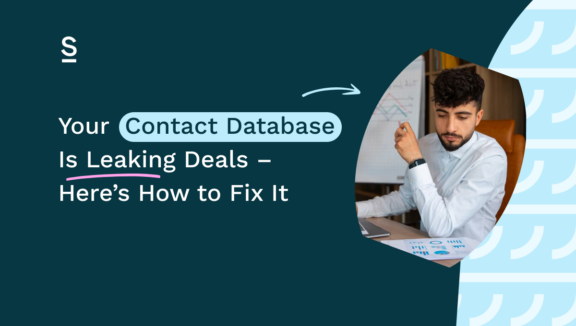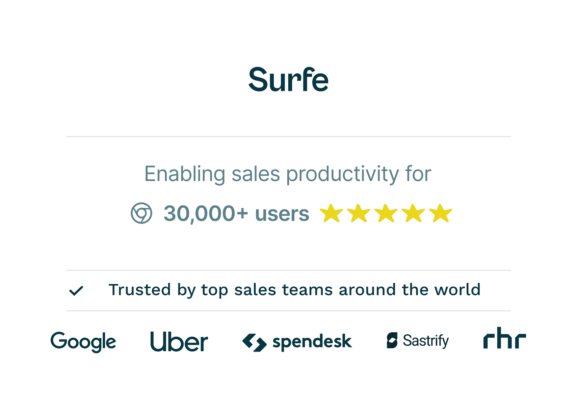Your Contact Database Is Leaking Deals – Here’s How to Fix It

Everyone has a one that got away.
No, we’re not talking about your love life – this is work, and we’re professionals, thank you very much – instead, we’re talking about that one lead that you never managed to close.
Maybe they went with a competitor, maybe the demo didn’t quite go to plan – or maybe it was your contact database. Yes, really.
Here’s the thing: a well-maintained contact database is the backbone of a successful sales strategy. Without it, leads fall through the cracks, opportunities are lost, and sales pros like you waste time on manual data entry instead of the important stuff. Plus, you’ll spend a lot of time worrying about data accuracy and security, and even more time on inefficient processes.
If this sounds familiar – don’t be afraid to admit it, we’re all friends here – then keep reading. Today, we’re going to show you how to fix your contact database – and how using a little tool called Surfe can help. Here’s what’s coming up:
- Why a Well-Managed Contact Database is Essential for Sales Success
- The Risks of Poor Contact Database Management
- The Need for Security and Compliance
- How an Intuitive Contact Database Optimizes Sales Pipelines
Ready to get over your one that got away, by replacing them with even better opportunities? Of course you are. Let’s go 👇
Why a Well-Managed Contact Database is Essential for Sales Success
So, why are we banging on about the importance of a well-managed contact database?
Well, a good contact database keeps lead and customer information up-to-date. In turn, clean and accurate data helps you run a structured sales process with better follow-ups – after all, you won’t accidentally double-email customers, call phone numbers that don’t work, or find out you’re working the same lead as your colleague.
We’re guessing, though, that you don’t just want a good contact database – you want the best type of contact database. The cream of the crop will also integrate with the rest of your tech stack, which allows you to stop wasting time on manual data entry – it handles all of that for you. Pretty dreamy, right?
Plus, when your sales team are all singing from the same hymn sheet (we mean contact database, if that wasn’t clear) you’ll be able to collaborate more quickly, more efficiently, and have more fun while doing so too.
The Risks of Poor Contact Database Management
There are a lot of good contact databases out there – but there are also a lot of bad ones. We’re talking those with missing, outdated, or inaccurate data, inconsistent entries, and poorly assigned leads. Have one of those, and you’ll suffer the consequences, like:
- Lost leads: if you have outdated or missing information attached to a contact, you’re going to struggle to run a good outbound campaign – and book them in for a demo.
- Wasted time: if your contact database has duplicate or incorrect data, you’re going to spend a lot of time realizing that dream lead is in fact already being handled by your peer, and hunting down accurate data to replace what’s in your contact database. In fact, inaccurate B2B contact data can waste up to 27.3% of your time. And we’ll guess that you don’t have over a quarter of your day to spare – just a hunch.
- Compliance risks: with GDPR and data protection laws in place, you’ve got to be super-careful in making sure there’s no one in your contact database that shouldn’t be. More on this in a minute!
- Missed sales opportunities: if you miss a prospect changing jobs or moving companies, you’re missing out on the valuable sales opportunities that come with a strategic “Congratulations!” note.

The Need for Security and Compliance
We’re sure we don’t need to tell you this, but it’s really, really important to manage your contact database in a way that’s GDPR-compliant. That means collecting data lawfully, storing it responsibly, keeping it accurate and up-to-date, and providing an easy way for prospects to access their data if requested.
If you’re sloppy on this front – say, you don’t store data securely or you have the details of someone you know, in your heart, isn’t really relevant – then it’s going to come back to bite you, usually in the form of a big legal risk. Not worth it.
How an Intuitive Contact Database Optimizes Sales Pipelines
So far, we’ve covered why you need a well-managed contact database and the risks of cutting corners. Now, let’s talk about how you can actually fix your contact database, and free up your time to focus on building relationships in the process.
First things first, think about your data entry: ideally, you want this to be automated, rather than something you have to do every.single.time you find a new lead you want to work with.
A little tool called Surfe (hey!) can help with that – you can choose to source your leads from LinkedIn or try out Surfe’s own contact database, which, spoiler alert, is really, really good. Once you’ve found some people you’d like to add to your contact database, Surfe will do it for you in just one click. Thanks to its clever integrations with LinkedIn and all major CRMs, you can say goodbye to painstakingly copying over email addresses and phone numbers, and hello to automated data entry that’s accurate every time.
Automated data transfer is good, but you also want to make sure that your contact database contents stay up-to-date. Forgive us for plugging ourselves again, but Surfe can also help with that. It keeps careful track of any changes your prospects are making – maybe they’re getting promotions, moving companies, or even just updating their email addresses – and lets you know about them in real time. You can then update their details in your contact database in just one click, and feel confident in your outreach efforts every single time.
When you’ve got a contact database that just, you know, works, you can stay confident in your view of your pipeline, and will forecast more effectively as a result. Nice.
Lets Wrap It Up!
Look at you, living a regret-free life!
When you have a contact database that’s accurate and secure, you’ll be able to do your job faster and more efficiently – which in turn means you won’t let a single lead slip through the cracks, ever again. Thank you, Surfe.
You’re welcome 😉 See you on the podium!

Ready to meet the contact database of your dreams?
Head right this way – just hit the button below to sign up for Surfe.
FAQs About Fixing Your Contact Database
What Is a Contact Database and Why Is It Important for Sales?
A contact database is a centralized system where businesses store prospect and customer details, including names, emails, phone numbers, and company information. A well-maintained contact database makes sure sales teams have accurate, up-to-date information, enabling better follow-ups, streamlined outreach, and stronger pipeline management. Without it, leads can fall through the cracks and opportunities can be lost. The best contact databases integrate with CRMs and other sales tools to automate data entry and updates, reducing manual work for sales pros and boosting their efficiency.
How Can a Poorly Managed Contact Database Hurt Sales Performance?
A poorly maintained contact database can slow down sales teams, waste time, and lead to missed deals. If contact details are outdated, reps may struggle to reach prospects or duplicate outreach efforts, which can lead to a poor prospect experience. Poor database hygiene can also cause compliance risks, especially with GDPR regulations. Keeping a clean, organized database makes sure every contact is properly assigned, updated, and ready for an effective outreach campaign.
How Do You Keep a Contact Database Accurate and Up to Date?
To maintain an accurate contact database, automate data entry and updates using tools that sync with LinkedIn and CRMs. Regularly clean the database by removing duplicates, fixing incorrect details, and updating job changes. Encourage sales teams to log interactions and confirm prospect details frequently. Using integrated sales tools like Surfe can help track job movements and enrich contacts with verified data, keeping data accurate without the hassle of manual updates.
What Are the Risks of Not Keeping a Contact Database GDPR-Compliant?
A non-compliant contact database can lead to hefty fines and legal issues under GDPR regulations. Sales teams must obtain consent before storing contact details, store data securely, and allow prospects to request data access or deletion. Keeping outdated or irrelevant contacts in the database is risky, as businesses must justify why they hold personal data. Automating compliance-friendly processes, such as permission tracking and secure data management, reduces these risks and keeps operations smooth.
How Can an Optimized Contact Database Improve Sales Efficiency?
An optimized contact database eliminates manual data entry, prevents duplicate records, and ensures every lead has complete, up-to-date contact details. This allows sales teams to focus on outreach rather than fixing data errors. Integrate your database with your tech stack, and you’ll reduce friction, improve collaboration, and remove the risk of human error. In turn, this frees up time to spend on personalizing their approach and responding faster.
What Tools Can Help Automate Contact Database Management?
CRM-integrated tools like Surfe automate contact database management by syncing LinkedIn contacts, updating job changes, and preventing manual data entry errors. These tools pull verified contact details into CRMs with one click, reducing manual input and ensuring accuracy. AI-driven solutions can also track prospect movements, ensuring that sales teams never miss an opportunity to re-engage leads. Automate your database upkeep, and you’ll save time, increase efficiency, and improve your performance.


